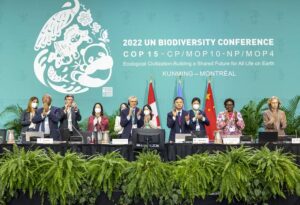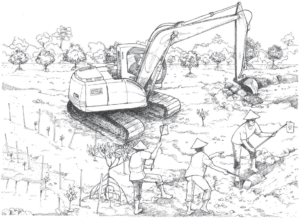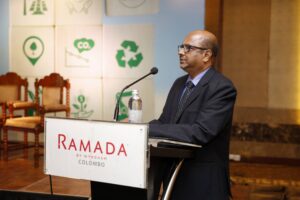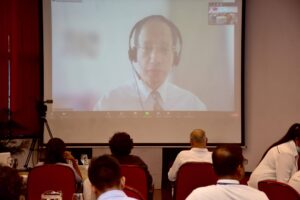By the end of COP26 of the United Nations Framework Convention on Climate Change (UNFCC), held in Glasgow, UK in November 2021, 151 countries had submitted new climate plans, known as nationally determined contributions, or NDCs to slash their carbon emissions by 2030. To keep the goal of limiting temperature rise to 1.5 degrees C within reach, we need to cut global emissions in half by the end of this decade. In contrast, the United Nations calculates that these plans, as they stand, but the world on track for 2.5 degrees C warming by the end of the century. That is better than the 4 degrees C trajectory the world was on before the Paris Agreement was struck, but still extremely dangerous.
But some 2030 targets of major emitters, particularly those from Australia, China, Saudi Arabia, Brazil, and Russia are so weak that they don’t offer credible pathways to achieve their net-zero targets. The Glasgow decision calls on countries to “revisit and strengthen” their 2030 targets by the end of 2022 to align them with the Paris Agreement’s temperature goals. In addition, the pact asks nations to consider further actions to curb potent non-CO2 gases, such as methane, and includes language emphasizing the need to “phase down unabated coal” and “phase-out fossil fuel subsidies.” This marked the first-time negotiators have explicitly referenced shifting away from coal and phasing out fossil fuel subsidies in the COP decision text.
This COP finally recognized the importance of nature for both reducing emissions and building resilience to the impacts of climate change, both in the formal text and also through a raft of initiatives announced on the sidelines. Once we see major emitters’ new climate targets by the end of 2022, we will have a much better idea of whether we will be able to avoid breaching that temperature threshold — and if we do breach it, by how much.
Financial Support for Developing Counties
- In 2009, rich nations committed to mobilizing $100 billion a year by 2020 and through 2025 to support climate efforts in developing countries. Developed countries failed to meet that goal in 2020. The COP26 outcome made it clear that these countries have not fulfilled this goal and stipulated that those countries must report on their progress. The post-2025 climate finance goal is expected to be set by 2024.
- Developed countries also agreed to at least double funding for adaptation by 2025, which would amount to at least $40 billion. This is a significant milestone to address the imbalance between funding for mitigation and adaptation efforts; adaptation finance currently amounts to only a quarter of total climate finance, while need to adapt to the increasing impacts of the climate crisis continues to grow.
- The Adaptation Fund reached unprecedented levels of contributions, with new pledges for $356 million that represent almost three times its mobilization target for 2022.
- COP26 also took steps to help developing countries access good quality finance options. For example, encouraging multilateral institutions to further consider the links between climate vulnerabilities and the need for concessional financial resources for developing countries — such as securing grants rather than loans to avoid increasing their debt burden.
Loss and Damage
COP26 finally put the critical issue of loss and damage squarely on the main stage. Climate change is already causing devastating losses of lives, land, and livelihoods. Some damages are permanent — from communities that are wiped out, to islands disappearing beneath the waves, to water resources that are drying up. Loss and damage are likely to be one of the bigger issues leading up to the COP27 summit in Egypt next year.
Significant outside the negotiations
- a bold commitment from India to reach net-zero emissions by 2070 including ambitious renewable energy targets for 2030)
- 109 countries signed up to the Global Methane Pledge to slash emissions by 30% by 2030
- A pledge by 141 countries to halt and reverse forest loss by 2030 (backed by $18 billion in funding, including $1.7 billion dedicated to support indigenous peoples).
- The UK announced the Glasgow Breakthroughs, a set of global targets meant to dramatically accelerate the innovation and use of clean technologies in five emissions-heavy sectors: power, road transport, steel, hydrogen, and agriculture
Where do we go from here?
- In the year ahead, major emitters need to ramp up their 2030 emissions reduction targets to align with 1.5 degrees C
- more robust approaches are needed to hold all actors accountable for the many commitments made in Glasgow, and much more attention is needed on how to meet the urgent needs of climate-vulnerable countries to help them deal with climate impacts and transition to net-zero economies.
- The Glasgow Climate Pact outlines the key steps to do so. But it is only once this is achieved that we will truly have a shot at reaching the 1.5 degrees C goal and building a safer and more just future for us all.
By the end of this century, Sri Lanka is likely to see an increase of 2-3 °C average temperature rise. There is likely to be significant inundation all around the coast, particularly in places like Negombo and Galle. The country has seen a historical increase, in both the number and intensity of droughts, floods, geographic changes, vector-borne diseases, coastal erosion, tropical storms, lightning, crop failures, landslides, and siltation of reservoirs. All of these are related, at least partially, to temperature and rainfall changes. These events have devastating and adverse impacts on our environment, citizens, infrastructure, businesses, and the national budget. The rising costs of climate change are being and will be, borne by the Sri Lankan public and by corporations that suffer damage. It is also being borne by future generations as the country increases its debt burden on this account. Likely, an inequitable proportion of these losses will be borne by poor and marginalized citizens, living along the banks of canals, rivers, and along the coast or residing in landslide-prone areas. Sri Lanka has little choice but to prepare for and adapt to climate change. Sri Lanka’s greenhouse gas emissions are minuscule in comparison to those of developed nations, India, or China. Climate We cannot stop climate change on our own, but we can prepare for it, safeguard ourselves from it, mitigate its impacts, and where we are the winners of climate change, we can capitalize and make the best of it.
What’s for Business
Over half of the UK’s largest businesses have committed to eliminate their contribution to carbon emissions by 2050. The UK government is calling on the global private sector to follow the UK’s example and join the UN Race to Zero. As of today, 60 of the UK’s FTSE 100 companies have signed up to the United Nation’s Race to Zero campaign – the largest ever global alliance committed to achieving net-zero carbon emissions by 2050 at the latest
Globally, over 5,200 companies of all sizes have now joined the UN Race to Zero, representing sectors like transport, technology, manufacturing, retail, and finance. Nearly half of these are British businesses, with the UK private sector demonstrating international leadership in global efforts to tackle climate change. The Race to Zero acts as a kickstart for companies going green, guiding their actions in the transition to net-zero and positioning businesses at the forefront of the global race to develop new green technology, kick-start new industries, and attract private investment. Businesses both large and small, across all sectors of the global economy, have a crucial role to play in both reducing their environmental impact and developing the green technologies that will set us on the path to net-zero.
Over 2,000 small businesses from across the UK have pledged to reduce their emissions and join the Race to Zero through the Together for Our Planet Business Climate Leaders campaign, launched to help small businesses go green. Acting on climate change will help businesses:
- grow
- seize new opportunities
- create new jobs,
- encourage investment
- adapt against the challenges of a changing planet
- reducing emissions can lower businesses’ running costs, save them money
- attract new customers
- maintain a competitive advantage locally and globally.
The commitments must build on the government’s Net Zero Strategy, which outlines measures to transition to a green and sustainable future.
- to take urgent action and demonstrate their climate leadership by signing-up to Race to Zero and setting out clear pathways to get to net zero.
- make tangible climate commitments that helps chart our path to net zero emissions by 2050.
- grasp the economic opportunities
- Step up to drive the innovation needed
- Net Zero awards – a competition launched to find the best small businesses taking innovative steps to cut greenhouse gas emissions. The Heroes of Net Zero Awards
We must make collective efforts to encourage businesses to go green. We call on all businesses, of all sizes, to pledge to go One Step Greener and sign up to the globally-recognized UN Race to Zero Climate Commitment so, they can protect the planet and their business, and help us start a green business revolution.

















